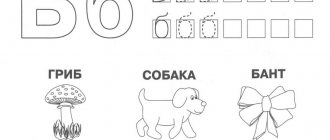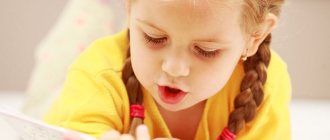Literacy lesson for the senior group. Topic: Sound “M”
Goal: introduce the sound “m” Objectives: 1. Clarify the correct articulation and sound of the sound [m]. 2. Develop the ability to distinguish a sound from others, to characterize the sound. 3. Form intonation expressiveness of speech. 4. Make comparative sentences with the conjunction “a”; 5. Strengthen the skill of forming diminutive forms of nouns; 6. Develop phonemic hearing, thinking, memory, attention, articulatory apparatus, pronunciation. 7. Develop the ability to control your speech, pronunciation, and voice power. Types of activities: gaming, cognitive, communicative, motor, health. Handout: Demonstration material: soft toy - cat,
Content:
The children sit in a semicircle on the carpet. 1. Organizational point: Hello, guys. Today someone came to visit us. Guess the riddle: He is crying at the threshold, hiding his claws, He will quietly enter the room, He will purr and sing. (Cat) A cat appears: Hello, guys. Let's get acquainted, my name is………. Oh, how forgetful I am. Please guess my name. It is encrypted in pictures, it must be identified by the first sound. (car, iron, steering wheel, sausage, watermelon) The pictures are located on the easel. What is my name? (Murka) That's right. Guys, what is that first sound? (Sound M). Let's talk about the sound M today. Say the sound - m. And tell me what it is? (consonant, voiced) Why? (lips close when pronouncing). Well done. Cat: You know, I have a girlfriend. Guess what her name is? Her name is also encrypted in the pictures, only not on the first sound, but on the last one. The pictures are attached to the back of the easel: house, snowflakes, table, crayfish, fish).
2. Sound analysis of the word - MURKA, MILKA. Educator: please come to your tables and use colored squares to lay out the name of our guest and her friend on the table. (Girls put the name MILKA out of colored squares, and boys - MURKA). Then ask one child at a time to conduct an analysis on the board, and everyone checks. The cat praises the children for correct answers.
3. Massage of biologically active zones “Kisonka” Children pronounce a simple phrase. In chorus. Sa-sa-sa - Beautiful kitty. Stroking Sy-sy-sy's head with palms - The kitty has a mustache. Run your fingers under Isa-isa-isa's nose - Milk for the kitty. Show lactating movements. Isa-isa-isa - The kitty plays with a bow. Rub your ears with your palms.
4. Make a proposal. The teacher asks the children to come up with a word that contains the sound -m- and make a sentence with it. (children make up sentences and tell them). Educator: write down your sentences using a graphic diagram in your notebook.
5. Phys. pause. Clap, clap, clap! Three claps. Top, top, top! Three floods. And under the desk there is a black cat. Squat down He crawled under the desk to sleep. Place your folded palms under your cheek. He prevents us from playing. Stand up and shake your finger.
6. Finger gymnastics. One, two, three, four, five, fingers went out for a walk. This finger is the strongest, thickest and largest. This finger is for showing it. This finger is the longest and stands in the middle. This ring finger is the most spoiled one. And the little finger, although small, is very dexterous and daring.
7. Work in a notebook. Teacher: everyone has a cat template on the table, circle it in a notebook and girls need to shade it: with straight lines from right to left, and boys – with wavy lines from top to bottom.
8. Reflection: What sound did the cat Murka introduce us to? (M sound) What is this sound? (consonant)
Target.Teach children to highlight the first consonant sound in a word;
introduce the letter Mm;
teach children to select action verbs for the proposed nouns; introduce a conventional (color) designation for hard consonants (blue) and soft consonants (green).
Equipment.
Pictures with sounds [m—m']; sticks; pictures of flowers; markers; sound houses.
Progress of the lesson
I. The teacher invites the children to meet one very interesting girl, Masha, and listen to a story.
1. — Once upon a time there lived Masha. Every day she came up with different games for herself. Today Masha woke up and thought: “Whatever sound I hear first, I’ll be friends with it all day long.” Masha went to the window and saw a cow and a cat. They sat opposite each other and talked. The cow mooed: “Moo-oo!” And the cat answered: “Meow!”
What is the first sound in a cow's song? ([m]).
What is the first sound in a cat's song? ([m']).
Masha smiled: “So today I’m playing and making friends with the sounds [m—m’].” Masha went to the kitchen where her mother was preparing breakfast. She told her mother: “You are the most important in my game, because your word has two sounds at once.”
- What two sounds did Masha mean? ([m]). Where in the word mother
can you hear the sound [m]? (At the beginning and middle of a word)
Masha went out into the garden. She wanted to pick a bouquet of flowers with the sounds [m—m']. Flowers grew in the flowerbed: irises, poppies,
peonies.
- What flowers do you think Masha picked? (Maki) Why? Masha returned with a bouquet of poppies.
I put them in a vase.
And on the table there was already semolina
porridge and
milk.
Masha laughed:
“Mommy,
what a great fellow you are!
You help me
in
my
game."
- Why did Masha say that? (In the words semolina, milk
- first sound [m]).
After breakfast, Masha went to the garden. We need to help mom prepare dinner. Masha
I picked
carrots
for soup,
raspberries
for compote.
- What is the first sound in the words carrot?
and
raspberries?
(Sound [m]).
Coming from the garden, Masha saw that there was pasta
and
meat
. The quick-witted girl realized that her mother would cook pasta the navy way.
— What sounds are heard at the beginning of the words pasta,
meat? (Sounds [m-m']).
Dad arrived at lunchtime. Seeing his daughter, dad asked: “What new game are you playing, Mashenka?”
“I play words with sounds [m—m'],” answered Masha.
“While mom is setting the table, I’ll play with you,” said dad, he sat Masha on his lap and began to ask her riddles. “I was driving through the field and saw this one with the sound [m] in the name:
Little animals
Gray fur coats,
Long tails
Little black eyes,
Sharp teeth. Who is this?" (Mice)
- Masha thought and guessed. Did you guess who Masha's dad saw?
“I brought you a toy. Guess it - it will be yours:
They beat him with a hand and a stick -
Nobody feels sorry for him.
Why are they beating the poor guy?
And because he’s inflated.” (Ball)
- Masha guessed this riddle right away. What about you, children?
2. Children, together with the teacher, compare the sounds [m-m'] in the words we sew
and
a ball.
It is determined that in the first word the sound is pronounced firmly, in the second word - softly.
Articulation of sounds.
When pronouncing sounds [m-m'], the lips are closed; there is an obstacle in the way of the air stream; the air stream seems to tear the lips.
The teacher agrees with the children that sounds whose pronunciation encounters obstacles in the mouth will be called consonants.
As can be seen from the examples, consonant sounds are hard and soft.
Characteristics of sounds.
Sounds [m-m'] - consonants; can be hard or soft.
II. 1. Sound analysis of words mouse
and
a ball
(with markers to color the windows in the houses).
2. Game situation “Focus”.
The teacher draws the children's attention to the diagrams of words on which the vowel sounds [m-m'] are painted over with a blue felt-tip pen.
— You and I discovered that consonants can be pronounced softly and firmly. But this is not visible in our diagram. How can we show that the sound [m] in the first word sounds hard, and in the second - soft, but the sun melted all its hardness?
The teacher takes a yellow felt-tip pen and paints over the blue square in the second word (as if a ray of sun had fallen on it). The blue square turns into green before the children's eyes. After this, a decision is made to designate soft consonants in green, and hard consonants remain blue. Red, as before, denotes a vowel sound.
III. Consolidation of new material.
1. The teacher offers to select and name from a pair of words those that begin with the sound [m'].
Example word pairs: oil
-
meat, poppy
-
ball, sea
-
stranded, mouse
-
bear, car
-
subway
, etc.
2. The teacher shows pictures with the sound [m] - the children select action verbs for them. For example: fly
-
flew, buzzed, got bored.
An approximate set of words: car (drove, stopped, carried), carrots (grew, turned green), pasta (lay, boiled, fried), mouse (ran, squeaked), boy (jumped, ran, drew, slept, played)
and etc.
IV. 1. Getting to know the image of a letter. The teacher asks the children:
- Do you think the sound [m] has its own sign - a letter? Does the sound [m'] have its own letter? I'll tell you the secret of our language: in Russian, hard and soft sounds are denoted by one letter. Now I will show you the letter that represents the sounds [m-m']. Display a demonstration letter and place it on the panel at the address: fourth floor (fourth row from the bottom), apartment No. 2 (second cell from the left). The flats for letters denoting consonant sounds are highlighted in blue.
2. Analytical and synthetic activities.
V. Game exercise “What elements does an object consist of?”
Goal: to train children in the ability to analyze an image and isolate its constituent elements.
The teacher draws schematic images of various objects (table, chair, snowman, etc.) on the board and asks them to answer the questions: what elements does the image of each object consist of? How many elements are there in total?





